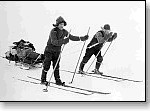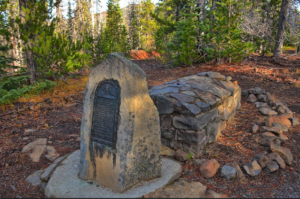Two miles west of the McKenzie Pass summit and the Dee Wright Observatory is the John Craig Memorial.
 John Craig was a legendary postmaster who, after attempting to ski Christmas mail over McKenzie Pass in the winter of 1877, was found frozen beside his mail pouch in his shack atop McKenzie Pass. For 25 years Craig carried mail from the Willamette Valley to Eastern Oregon, by horseback in the summer and on his own back in the winter. Mystery still shrouds the details of his death, but a few details of his life give some insights to his stubborn pioneer spirit.
John Craig was a legendary postmaster who, after attempting to ski Christmas mail over McKenzie Pass in the winter of 1877, was found frozen beside his mail pouch in his shack atop McKenzie Pass. For 25 years Craig carried mail from the Willamette Valley to Eastern Oregon, by horseback in the summer and on his own back in the winter. Mystery still shrouds the details of his death, but a few details of his life give some insights to his stubborn pioneer spirit.
John Templeton Craig was born in 1832 and grew up in the McKenzie Valley. In 1862, Craig was one of 50 men hired by Captain Felix Scott to build a trail from Eugene over the Cascades. By then the rush of westward-bound Oregon Trail pioneers had slowed, but the discovery of gold in Eastern Oregon prompted a flood of people heading eastward. Scott plan was to sell Willamette cattle to the hungry miners east of the Cascades.
As Scott’s road-building crew neared the lowest route across the mountains they encountered miles of snow and jagged lava fields at McKenzie Pass. Craig favored chipping out a road through the lava fields, but Scott decided to skirt the lava fields in favor of a notch at Scott’s Pass on the shoulder of North Sister that was 1000 foot higher, steeper and crossed more snow. Scott’s route was later abandoned and is known today as the Scott Trail in the Three Sisters Wilderness.
After working for Scott, Craig spent the next 15 years working for himself while championing his vision of a lower crossing through McKenzie Pass. In 1871 he formed the McKenzie, Salt Springs and Deschutes Wagon Road Company and began to build his toll road. He cut trees, chipped and chiseled a roadbed out of the jagged lava fields just north of North Sister to form a McKenzie Pass crossing lower than what was available at the time.
By the Fall of 1872 he had his road open and began collecting tolls of $2 for a wagon, $1 for a horseback rider, 10¢ for cattle and 5¢ for sheep. After its completion he won a federal contract to deliver mail from the Willamette Valley to Camp Polk in Central Oregon over the road. In summer the mail was carried on horseback. In winter it was carried on John Craig’s back. To accommodate the mail carrier, a small cabin was built about half way across, in which he could spend the night.
On December 3, 1877 John Craig set out on skis from the McKenzie Bridge, eastbound over the McKenzie Pass with the Christmas mail in a heavy backpack. He never made it to Central Oregon, and he never returned. His body was found in the spring of 1878, curled up in the ashes of the fireplace of the cabin he had built at the pass to spend the night in.
It is believed that Craig, suffering from exhaustion and possibly ill, reached the cabin, built a fire and fell asleep. He apparently awoke in the middle of the night to find the fire had gone out and failed in his attempts to rekindle the fire. It is believed that the half frozen man crawled into the ashes for warmth where he froze to death.
The John Craig Memorial monument, located about 2 miles west of the Dee Wright Observatory, was dedicated to Craig in 1930 by 400 of Oregon’s rural mail carriers. Four years later the first John Craig Memorial Ski Race was held, and the race was staged intermittently for several decades afterward.
In 1972 the Oregon Nordic Club took over the ski race and has held some form of event to and back from the pass nearly every year since to honor Craig’s memory and to get people interested in Nordic skiing. Craig’s story provides an interesting underlying theme, and serves to impress upon people the hardships of carrying the mail across the pass at that time. “This is one of those great ski traditions,” said volunteer JD Downing, coach for XC Oregon, “I wish more people knew about it.”
Dee Wright ObservatorySkiers of all ages and ability levels are encouraged to participate in the event, but also to “use common sense” about how far to go before turning around. In good weather an average skier can reach Dee Wright Observatory in about three hours and Windy Point in two, and skiers can expect to get down from the pass in about half the amount of time they took to climb.


